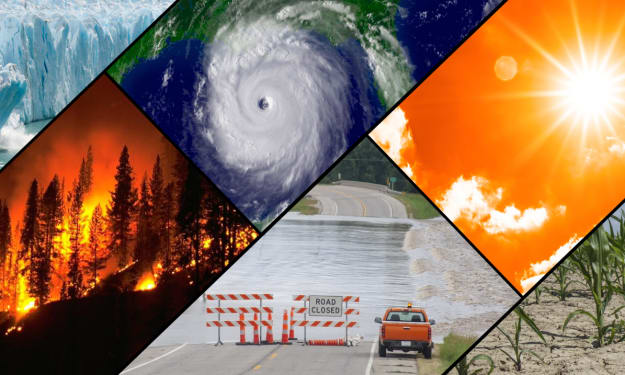Crisis Unleashed: Decoding the Terrifying Surge in Hurricane Fury Part 1
The Alarming Nexus of Climate Change, Ocean Rage, and Human Vulnerability

Introduction
Hurricanes, nature's most powerful and destructive storms, have long captured our awe and fear. However, in recent years, a disquieting narrative has taken root - the belief that hurricanes are growing more dangerous with each passing season. Are these fears founded in reality, or are they mere perceptions fueled by media coverage? In this comprehensive exploration, we embark on a journey to dissect the intricate relationship between climate change and the escalating fury of hurricanes.
Historical Context
Historical Overview of Hurricanes
To understand the present, we must first turn back the pages of time. Hurricanes have been a part of Earth's climatic tapestry for centuries, their stories chronicled in ancient texts and passed down through generations. Early civilizations regarded these tempests as divine wrath or the workings of mythical sea creatures, struggling to comprehend their ferocity.
Notable Hurricanes and Their Impacts
Throughout history, certain hurricanes have left an indelible mark on our collective memory due to their sheer devastation. Hurricanes like Katrina in 2005, Harvey in 2017, and Maria in the same year serve as stark reminders of nature's unyielding power. These storms submerged cities, deluged landscapes, and disrupted lives on an unprecedented scale, necessitating extensive recovery and rebuilding efforts.
Comparing Historical Data with Recent Trends
But do these recent hurricanes truly signal a trend of escalating fury? To answer this question, we must scrutinize historical hurricane data and compare it with contemporary trends. Historical records reveal that hurricanes have always possessed the potential for devastation. Yet, the statistical evidence suggests an unsettling pattern: an increasing number of high-intensity hurricanes in recent years.
Understanding Hurricanes
Anatomy of a Hurricane
To comprehend the link between hurricanes and climate change, we must first understand the anatomy of these monstrous storms. Hurricanes are colossal heat engines fueled by warm ocean waters, moisture-laden air, and complex atmospheric dynamics. Their development and intensification are a product of the intricate interplay of these elements.
The Life Cycle of a Hurricane
Hurricanes undergo a predictable life cycle, characterized by distinct stages from formation to dissipation. Understanding this life cycle is crucial to deciphering how climate change can influence their behavior.
Factors Influencing Hurricane Formation and Intensity
Multiple factors influence the formation and intensity of hurricanes. These include sea surface temperatures, atmospheric moisture levels, wind patterns, and more. Climate change can alter these factors, potentially magnifying hurricane impacts.
Climate Change and Global Warming
The Greenhouse Effect and Its Drivers
To grasp the connection between climate change and hurricanes, we must first delve into the greenhouse effect. The greenhouse effect is the natural process by which certain gases in the Earth's atmosphere trap heat, maintaining a suitable temperature for life. However, human activities, such as burning fossil fuels, have significantly intensified this effect, leading to global warming.
The Role of Greenhouse Gases
Greenhouse gases, such as carbon dioxide (CO2) and methane (CH4), are the main culprits behind the enhanced greenhouse effect. These gases trap heat and lead to a rise in global temperatures, setting the stage for changes in weather patterns and, potentially, hurricanes.
Evidence of Global Temperature Rise
Over the past century, there has been a notable increase in global temperatures, primarily driven by human activities. The accumulation of greenhouse gases in the atmosphere has amplified the Earth's natural greenhouse effect, resulting in a phenomenon known as global warming.
Ocean Temperatures and Hurricane Formation
The Link Between Warm Ocean Waters and Hurricanes
Warm ocean waters serve as the primary energy source for hurricanes. When sea surface temperatures reach a critical threshold, heat is transferred from the ocean to the atmosphere, setting the stage for storm formation.
Rising Sea Temperatures and Their Impact
As global temperatures rise due to climate change, the world's oceans are not immune to this warming trend. Rising sea temperatures have profound implications for hurricanes, potentially increasing their intensity and destructive potential.
Case Studies Illustrating the Connection
Real-world examples, such as the increasing prevalence of Category 4 and 5 hurricanes, offer compelling evidence of the relationship between rising sea temperatures and more dangerous hurricanes. The recent surge in such high-intensity storms demands our attention and scrutiny.
Changing Ocean Currents
Ocean Currents and Hurricane Patterns
Ocean currents, the massive, slow-moving flows of seawater, play a pivotal role in shaping hurricane patterns. They distribute heat around the globe, influencing the conditions necessary for hurricane development.
Altered Ocean Currents and Hurricane Behavior
Climate change can disrupt these oceanic circulations, leading to alterations in current patterns. Such changes can have far-reaching consequences, potentially affecting the frequency, intensity, and paths of hurricanes.
Real-World Examples of Altered Currents
From the shifting currents in the North Atlantic to the El Niño and La Niña phenomena in the Pacific Ocean, there are numerous real-world examples of how altered ocean currents can impact hurricane behavior. Understanding these dynamics is key to unraveling the complexity of hurricanes in a changing climate.
Atmospheric Moisture and Rainfall
How a Warmer Atmosphere Holds More Moisture
A warmer atmosphere has the capacity to hold more moisture, a fundamental principle of climate science. This increase in atmospheric moisture content can significantly influence hurricane dynamics.
The Correlation Between Atmospheric Moisture and Hurricane Rainfall
The connection between atmospheric moisture and hurricane rainfall is a critical one. As hurricanes draw moisture from the warm ocean surface into their swirling cores, they unleash torrential rains upon landfall, often leading to catastrophic flooding.
Case Studies Demonstrating the Link
Real-world case studies, such as Hurricane Harvey's record-breaking rainfall in Houston in 2017, vividly illustrate the correlation between atmospheric moisture and hurricane rainfall. Understanding this relationship is essential for assessing the evolving threat of hurricanes in a warming world.
End of Part 1.
To be continued...
About the Creator
Lyndon Prince
I'm Lyndon Prince, a passionate writer on a quest to inspire through words.
📚 What You'll Find Here:
Explore captivating articles covering a wide range of topics.
🌍 Join Me:
Let's embark on a literary journey together.
Enjoyed the story? Support the Creator.
Subscribe for free to receive all their stories in your feed. You could also pledge your support or give them a one-off tip, letting them know you appreciate their work.





Comments
There are no comments for this story
Be the first to respond and start the conversation.